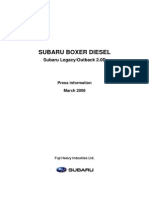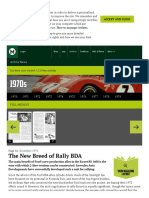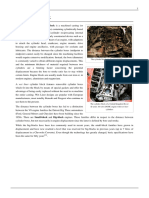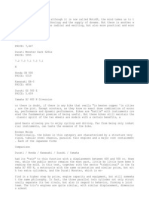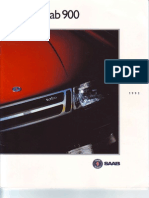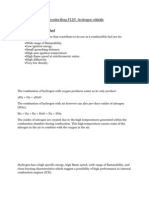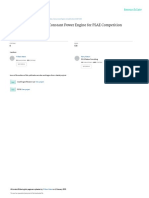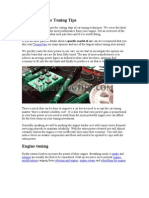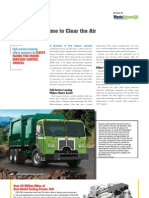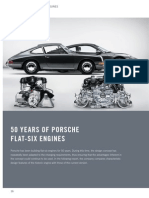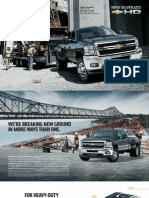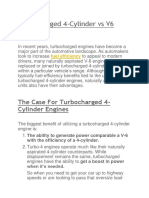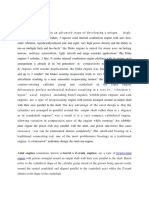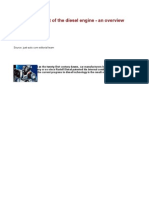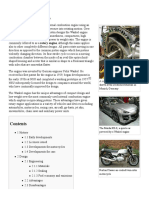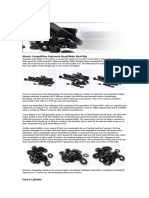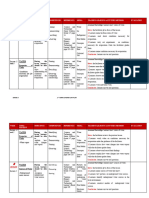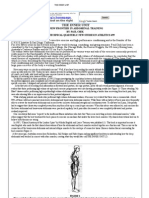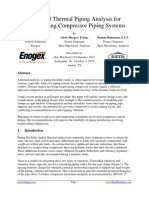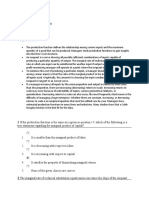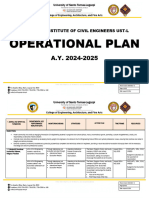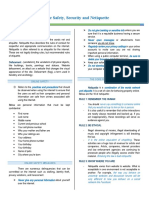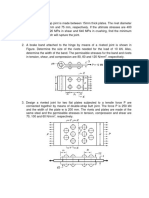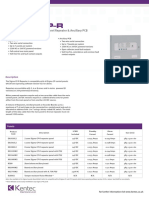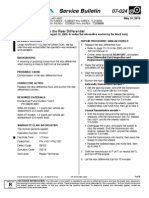SUBARU BOXER DIESEL - A True Engineering Revolution
SUBARU BOXER DIESEL - A True Engineering Revolution
Uploaded by
Alvaro ContenteCopyright:
Available Formats
SUBARU BOXER DIESEL - A True Engineering Revolution
SUBARU BOXER DIESEL - A True Engineering Revolution
Uploaded by
Alvaro ContenteOriginal Title
Copyright
Available Formats
Share this document
Did you find this document useful?
Is this content inappropriate?
Copyright:
Available Formats
SUBARU BOXER DIESEL - A True Engineering Revolution
SUBARU BOXER DIESEL - A True Engineering Revolution
Uploaded by
Alvaro ContenteCopyright:
Available Formats
11/28/11
SUBARU BOXER DIESEL A True Engineering Revolution
The initial development w ork for the w orld s first BOXER DIESEL for passenger cars began in 1999 w ith a team of only four engineers. By that time diesel engine performance had been dramatically improved through technological advances in the control of combustion, and the diesel engine had proven to be a promising pow er unit w ith even less carbon dioxide emission. Automobile manufacturers around the w orld w ere then in the midst of an increasingly keen competition in developing high-performance diesel engines. When Subaru started its development project for the BOXER DIESEL, w e soon realized that w e w ere in an unprecedented, unchartered area in diesel engine development and w ere undertaking a technological challenge for w hich no benchmarking comparisons existed. Compared to those in a gasoline engine, the dimensions of bore and stroke differ in a diesel engine. The difference betw een the tw o stems from dissimilar combustion mechanisms: the combustion chamber in the diesel engine is usually more compact to facilitate compression ignition by injecting fuel directly into the combustion chamber. The diameter of the piston is made longer to increase gasoline engine displacement. In the diesel engine, how ever, enlarging the bore leads to a bigger chamber, w hich doesn t support efficient combustion. To address this issue, the bore is made shorter and the stroke longer in a conventional inline diesel engine to increase engine displacement, yet, in the layout of the BOXER DIESEL, w hich features horizontally opposed cylinders, an elongated stroke w ould w iden the engine, making it impossible to fit it under the hood. Consequently, at the beginning of our project, w hen Subaru discussed the development of the BOXER DIESEL w ith allied automakers or a research institute specialized in diesel engines, they concluded that the boxer configuration is not structurally suitable for diesel engines. Subaru then also considered the possibilities of developing a new inline diesel engine or purchasing a diesel engine from another manufacturer. In light of this situation Subaru engineers reflected on our fundamental philosophy of developing Subaru brand identity. What sets Subaru apart from others is the BOXER engine in combination w ith AWD technology, w hich provides outstanding driving performance coupled w ith safety and environmental features. The engineers w ere convinced that this unique brand identity must be incorporated in the new diesel engine. Satoshi Maeda, a general manager of the Engine Design Department w ho led the development team, remembers that conviction. It made no sense that w e w ould just create a new 2-liter diesel engine w ithout thinking about the Subaru brand identity. Diesel engines w ere already considered more economical and durable than gasoline engines, and the need for developing diesel engines w as great. But w e believed that an innovative diesel engine w ith our brand identity w ould generate high demandand that the SUBARU BOXER DIESEL w ould distinguish itself from diesel engines made by Mercedes or one by Audi. We w ere sure that ours must be in the boxer configuration.
Along those lines, advantages of the boxer engine w ere further discussed. Diesel engines generally provide more torque, but they produce more noise and vibration than gasoline engines, because combustion pressure created inside a diesel engine is tw ice as pow erful as that of a gasoline engine. Almost all inline diesel engines come w ith balance shafts to reduce noise and vibration. In addition, diesel engines are generally larger and heavier than gasoline engines, since they must w ithstand strong combustion pressure. Placing a heavier engine in a car affects the w eight distribution of the vehicle in motion and may impinge on agility. The BOXER engine, how ever, cancels out inertial forces that cause vibration and noise, thanks to their horizontally opposed pistons. The compact and simply designed BOXER requires no balance shafts. The BOXER engine configuration is also structurally rigid. Unlike inline diesel engines, the BOXER DIESEL features low vibration, a low center of gravity, and high rigidity. The advantages of the BOXER DIESEL became obvious to the engineers, w hich further encouraged them in their endeavors. The first BOXER DIESEL prototype w as completed in 2004. In November of that year, a trial model w as placed on the test bench and started. The engineers observed stable idling, low vibration, and pow erful boost. They w ere convinced of the success of their BOXER DIESEL.
Terms and conditions Privacy Policy Link to Distributors
Copyright Fuji Heavy Industries Ltd. 2008 All Rights Reserved.
Global Site BOXER DIESEL.com<
*Details of specifications and equipment may vary according to market.
www.boxerdiesel.com/engineering/en/01.html
1/1
You might also like
- Volvo Turbocharged B230 TuningDocument14 pagesVolvo Turbocharged B230 TuningEdik Panjaitan100% (2)
- Aerodynamics of The New BMW Z4Document24 pagesAerodynamics of The New BMW Z4VyssionNo ratings yet
- Subaru Boxer DieselDocument15 pagesSubaru Boxer DieselAlberto Torres LeonNo ratings yet
- Different Types of Car EngineDocument8 pagesDifferent Types of Car EngineHarish Padmanaban75% (4)
- 9070 Series Sts Combines 9570sts 9670sts 9770sts 9870sts PDFDocument2 pages9070 Series Sts Combines 9570sts 9670sts 9770sts 9870sts PDFRafael DelaiNo ratings yet
- Stefan Molyneux Masters ThesisDocument99 pagesStefan Molyneux Masters ThesisJohnnyOneNo ratings yet
- FHI Develops A New-Generation Subaru Boxer EngineDocument2 pagesFHI Develops A New-Generation Subaru Boxer EngineVICTORMARCENo ratings yet
- BMW 3.0L I-6 M57: Small Displacement Diesel: Diesel Cars Diesel EnginesDocument1 pageBMW 3.0L I-6 M57: Small Displacement Diesel: Diesel Cars Diesel EnginesRolando JimenezNo ratings yet
- Sabre V8Document16 pagesSabre V8stefan.vince536No ratings yet
- The New Breed of Rally BDA: Motor SportDocument8 pagesThe New Breed of Rally BDA: Motor SportHarold MorleyNo ratings yet
- Outback H6 BroshureDocument10 pagesOutback H6 BroshureDima DemomanNo ratings yet
- W220 Propeller Drive Tail Shaft Refurbishment DIY 2Document14 pagesW220 Propeller Drive Tail Shaft Refurbishment DIY 2Noah StrausserNo ratings yet
- Cylinder Block: The Cylinder Block of A Ford I4 DOHC EngineDocument4 pagesCylinder Block: The Cylinder Block of A Ford I4 DOHC Enginemarcelino c. cabralNo ratings yet
- Engine Series: Stroker Engines - Making Bigger Even 'Badder'Document4 pagesEngine Series: Stroker Engines - Making Bigger Even 'Badder'Walid BenaziNo ratings yet
- 81 Saab 900 Brochure (OCR)Document40 pages81 Saab 900 Brochure (OCR)mnbvqwertNo ratings yet
- Design of A Custom FSAE EngineDocument16 pagesDesign of A Custom FSAE Engineuniejleite.fei.engineeringNo ratings yet
- Ford EcoBoostDocument22 pagesFord EcoBoostmilanstr100% (1)
- How to Power Tune Harley Davidson 1340 Evolution Engines: For Road & TrackFrom EverandHow to Power Tune Harley Davidson 1340 Evolution Engines: For Road & TrackNo ratings yet
- 990039Document9 pages990039some_guy8888No ratings yet
- Comparison Saveur 2002-09-10 - Suzuki GS 500 E, Kawasaki ER 5, Honda CB 500, Yamaha XJ 600 NDocument9 pagesComparison Saveur 2002-09-10 - Suzuki GS 500 E, Kawasaki ER 5, Honda CB 500, Yamaha XJ 600 N4gen_2No ratings yet
- 82 Saab 900 Brochure (OCR)Document32 pages82 Saab 900 Brochure (OCR)mnbvqwert100% (1)
- Chapter 1 Engine: SpecificationsDocument9 pagesChapter 1 Engine: Specificationsmdias_650100No ratings yet
- DF350A Product Information en WEBDocument44 pagesDF350A Product Information en WEBPETERNo ratings yet
- USA - 1992 Saab 900 BrochureDocument38 pagesUSA - 1992 Saab 900 BrochuremnbvqwertNo ratings yet
- Tuning Standard Triumphs VizardDocument159 pagesTuning Standard Triumphs VizardJadera1989100% (1)
- MercedesDocument5 pagesMercedesParth BhattNo ratings yet
- Development of A 430cc Constant Power Engine For FSAE CompetitionDocument8 pagesDevelopment of A 430cc Constant Power Engine For FSAE CompetitionLuizGustavoVicenteNo ratings yet
- GM Crate Engine BuyerDocument18 pagesGM Crate Engine BuyerEngine Tuning UPNo ratings yet
- Multi-Cylinder Ngines How An Sers Enefit From Ulti-Ngines in Otorcycle?Document8 pagesMulti-Cylinder Ngines How An Sers Enefit From Ulti-Ngines in Otorcycle?Rokia BenzergaNo ratings yet
- Rebirth of Diesel Engine ArticleDocument2 pagesRebirth of Diesel Engine ArticleMuhammad Fathin JuzarNo ratings yet
- Wartsila - Medium Speed Diesel EnginesDocument20 pagesWartsila - Medium Speed Diesel Enginesalberto_rdNo ratings yet
- MBE4000 BrochureDocument6 pagesMBE4000 BrochureAleksey ReshinNo ratings yet
- Welcome To Car Tuning TipsDocument60 pagesWelcome To Car Tuning TipsVeer Honda100% (1)
- New Engines: Time To Clear The Air: TrucksDocument4 pagesNew Engines: Time To Clear The Air: TrucksjohnribarNo ratings yet
- Tvs Wego ProjectsDocument32 pagesTvs Wego ProjectsMayank Jain Neer100% (1)
- Boxer Engine: Group 4 MembersDocument3 pagesBoxer Engine: Group 4 MembersHamed Quenta AlvarezNo ratings yet
- NewsletterDocument29 pagesNewsletterWASSAABNo ratings yet
- (SpeedPro) Des Hammill - How To Power Tune Ford V8 - 221, 255, 260, 289, 302 & 351 Cu in Smallblock Engines For Road and Track-Veloce Publishing LTD (2014)Document345 pages(SpeedPro) Des Hammill - How To Power Tune Ford V8 - 221, 255, 260, 289, 302 & 351 Cu in Smallblock Engines For Road and Track-Veloce Publishing LTD (2014)Tomas MartinčićNo ratings yet
- 32 Valve HeadsarticleDocument9 pages32 Valve HeadsarticleITLHAPN100% (1)
- ComfortClass S407 USADocument20 pagesComfortClass S407 USAPhilippine Bus Enthusiasts SocietyNo ratings yet
- 2014 1 Porsche Turbo Nemturbo 50 EvDocument8 pages2014 1 Porsche Turbo Nemturbo 50 EvBenedek Zoltán100% (2)
- 2011 Chevrolet Silverado 3500HD - Carter Chevrolet - Manchester, CTDocument20 pages2011 Chevrolet Silverado 3500HD - Carter Chevrolet - Manchester, CTCarter Chevrolet CO, INC.No ratings yet
- Alfasud 8v EngineDocument6 pagesAlfasud 8v EngineAlexandru IonescuNo ratings yet
- Benchmarking in v6 EngineDocument13 pagesBenchmarking in v6 Engineshashwat bajpaiNo ratings yet
- Bajaj Pulsar Research Report FinalDocument81 pagesBajaj Pulsar Research Report FinalSudhanshu RaiNo ratings yet
- Chassis Design Analysis AssignmentDocument6 pagesChassis Design Analysis AssignmentheltaherNo ratings yet
- EV Skateboard Chassis For HD and LD CommercialDocument20 pagesEV Skateboard Chassis For HD and LD CommercialRitwik GuptaNo ratings yet
- Chassis Design Analysis AssignmentDocument6 pagesChassis Design Analysis AssignmentEddie HimselfNo ratings yet
- Axial Engines (Sometimes Known As Barrel or Z-Crank Engines) Are A Type ofDocument11 pagesAxial Engines (Sometimes Known As Barrel or Z-Crank Engines) Are A Type ofrajnagpNo ratings yet
- Ways To Modify and Increase The Performance of GY6 ScootersDocument4 pagesWays To Modify and Increase The Performance of GY6 Scooterssteve_t_davis100% (2)
- EE 422 GBHJDocument10 pagesEE 422 GBHJVon Andrae A PanesNo ratings yet
- Marketing Mix - SecA - Group5 - KTM Duke200 Vs Pulsar RS200Document15 pagesMarketing Mix - SecA - Group5 - KTM Duke200 Vs Pulsar RS200Divyanshu AryaNo ratings yet
- Rotary e PDFDocument35 pagesRotary e PDFPaul Dumitru100% (1)
- The Development of The Diesel Engine - An OverviewDocument37 pagesThe Development of The Diesel Engine - An OverviewArun KmrNo ratings yet
- Wankel EngineDocument28 pagesWankel EngineSARATH KRISHNAKUMARNo ratings yet
- Stud KitsDocument2 pagesStud KitsMr KayNo ratings yet
- OM642 LS 2010Document8 pagesOM642 LS 2010messmer.williamNo ratings yet
- Porsche - US Cayenne-Diesel - 2012 PDFDocument19 pagesPorsche - US Cayenne-Diesel - 2012 PDFSculatorNo ratings yet
- Eric Swann and David S. Hibbet Plus Notes From Alexopoulos and BlackwellDocument90 pagesEric Swann and David S. Hibbet Plus Notes From Alexopoulos and BlackwellChristian Martell LiwagNo ratings yet
- Grade 5 Science Scheme-CumDocument4 pagesGrade 5 Science Scheme-Cumalmightykeno1991No ratings yet
- St. Patrick Kigulu Girls' Boarding Primary School Revision Test 2020 Primary Two Literacy NAME: - STREAM: - Section ADocument5 pagesSt. Patrick Kigulu Girls' Boarding Primary School Revision Test 2020 Primary Two Literacy NAME: - STREAM: - Section AMutoto RobertNo ratings yet
- Unit IIIDocument28 pagesUnit IIINirav AgarwalNo ratings yet
- The Inner UnitDocument6 pagesThe Inner UnitsololuiNo ratings yet
- Vidi-RGB Manual: 1990 ROMBO ProductionsDocument12 pagesVidi-RGB Manual: 1990 ROMBO ProductionselgauchoandresNo ratings yet
- Load-Bearing Tilt-Up Concrete Wall PanelsDocument149 pagesLoad-Bearing Tilt-Up Concrete Wall PanelsxufafruitjuiceNo ratings yet
- Improved Thermal Piping Analysis For Reciprocating Compressor Piping SystemsDocument7 pagesImproved Thermal Piping Analysis For Reciprocating Compressor Piping SystemsJimmy Alexander AvilaNo ratings yet
- Hydrogen Peroxide PDFDocument20 pagesHydrogen Peroxide PDFzibaNo ratings yet
- Ce-222 Soil Mechanics - I-Dr Kamran Akhtar (Revision 013)Document4 pagesCe-222 Soil Mechanics - I-Dr Kamran Akhtar (Revision 013)Nust RaziNo ratings yet
- KidsHealthyEatingPlate Guide Jan2016Document4 pagesKidsHealthyEatingPlate Guide Jan2016annaafia6No ratings yet
- Chapter 5: Production Production TheoryDocument7 pagesChapter 5: Production Production TheoryPoudel SathiNo ratings yet
- Installation&Maintenance GuideDocument78 pagesInstallation&Maintenance Guidediegomatiz1609No ratings yet
- PICE-OPLAN-24-25 (Edited)Document10 pagesPICE-OPLAN-24-25 (Edited)JANETH IRISH CAMATANo ratings yet
- Pex 08 04Document4 pagesPex 08 04holaNo ratings yet
- PMP 450m Training - Liquid Telecom UgandaDocument65 pagesPMP 450m Training - Liquid Telecom UgandaDavid T. RomanNo ratings yet
- Pregnancy at Risk Preexisting ConditionsDocument39 pagesPregnancy at Risk Preexisting ConditionsMatthew RyanNo ratings yet
- Exercise 01Document2 pagesExercise 01Phuong DoanNo ratings yet
- Online Saftety, Security and NetiquetteDocument4 pagesOnline Saftety, Security and NetiquetteDIACHEL AMANTENo ratings yet
- assignment riveted jointDocument2 pagesassignment riveted jointPuspita DasNo ratings yet
- Proposed Biophilic Designed Agro-Industiral EstateDocument41 pagesProposed Biophilic Designed Agro-Industiral EstatePK TugadeNo ratings yet
- ONE WAY TOS IfurungDocument2 pagesONE WAY TOS IfurungJohn Lewis SuguitanNo ratings yet
- Investigatory ProjectDocument26 pagesInvestigatory ProjectSK SOFIQUEE FIAZ100% (1)
- Sigma CP-R: Conventional Fire Alarm Control Panel Repeater & Ancillary PCBDocument2 pagesSigma CP-R: Conventional Fire Alarm Control Panel Repeater & Ancillary PCBEngTyranNo ratings yet
- A07 024Document2 pagesA07 024r3388No ratings yet
- Transient Measurement of The Junction-To-Case Thermal ResistanceDocument7 pagesTransient Measurement of The Junction-To-Case Thermal ResistancequantumflightNo ratings yet
- Esearch Anagement Uidelines: Jimmy G. Gula, Ed.DDocument66 pagesEsearch Anagement Uidelines: Jimmy G. Gula, Ed.DSheryl Daroy MondranoNo ratings yet
- How To Implement Open Innovation: Lessons From Studying Large Multinational CompaniesDocument33 pagesHow To Implement Open Innovation: Lessons From Studying Large Multinational CompaniesDarshiniNo ratings yet


